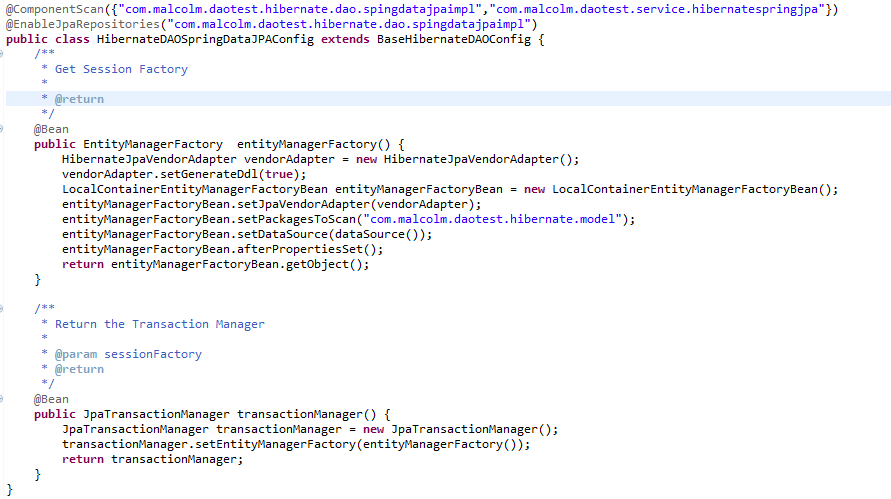Spring-Data project makes it
easier to use data access technologies be it relational databases, NoSQL
non-relational databases or other data services. Spring-Data contains many sub-projects that
are specific to a given data access technology, we will primarily look at spring
Data JPA technology, which makes it easier to access JPA implementations.
Core Interfaces:
Repository:
Repository is the central core
interface when it comes to using Spring Data; not to be confused with the
Repository annotation which has been in spring 2.0, The Repository interface is
marker interface which captures the domain type to manage as well as the domain
type's id type.
CRUDRepository:
The CRUDRepository interface
extends the Repository interface and provides CRUD (Create Read Update and
Delete) functionalities for the managed entity object. The CRUDRepository provides the
following functionality:
- Save - Saves and returns the entity which can be used further operations
- findOne – Finds and returns an entity by its primary id
- findAll – Returns list of all entities of the type
- exists – Checks and returns boolean value for existence of the entity by primary key
- count – Returns the count of number on entities available
- delete – Deletes the entity
- deleteAll – Deletes all the entities managed by the repository.
PagingAndSortingRepository:
The PagingAndSortingRepository
extends the CRUDRepository and provides functionality for pagination and
sorting.
JpaRepository:
The JPARepository extends the PagingAndSortingRepository to provide JPA specific extensions for the repository, Additional attributes to gain more detailed control over the setup of the repositories specifying EntityManager and TransactionManager references can be done via xml of through spring configuration object.
Query Methods
Standard CRUD functionality usually has queries on the
underlying data store and generally these may be mapped SQL statements or named
queries, but with Spring-Data the underlying query can be generated
automatically by the repository. The repository proxy has two ways to derive a
store-specific query from the method name. It can derive the query from the
method name directly, or by using a manually defined query depending upon following
the Query lookup strategies.
CREATE - Construct a query from the query method name by removing
given set of well-known prefixes from the method name and parse the rest of the
method.
USE_DECLARED_QUERY – Will try to find a declared query and
will throw an exception in case it can't find one. The query can be defined by
an annotation somewhere or declared by other means.
CREATE_IF_NOT_FOUND – This is the default strategy that combines
CREATE and USE_DECLARED_QUERY. It looks up a declared query first, and if no
declared query is found, it creates a custom method name-based query.
The query look up mechanism strips prefixes find…By,
read…By, query…By, count…By, and get…By from the method and starts parsing the
rest of it.
Please refer to the Spring-Data
reference for more details on query look up styles.
@Query
Using named query in JPA is a
very valid approach for annotating model objects and then referring to the
named queries in the data access object, however with this approach the entity
model soon becomes cluttered with named query and the DAO classes may get hard
to read since you would be going back and forth between the actual query and
the DAO class where it is used.
The Spring-Data @Query annotation
makes is very simple to annotate queries in the repository interface and use
them in the repository itself, native queries easily supported by marking
nativeQuery attribute as true. Named query parameters are also easily
supported.
Please refer to the Spring-Data reference for more details on @Query examples.
Spring Data JPA Implementation:
Please refer to previous post if you plan to import the test project onto local machine and run code locally.Annotated Model Object:
The com.malcolm.daotest.hibernate.model package contains JPA annotated model, which is pretty straight forward. We annotate each Java object with the @Entity,
The com.malcolm.daotest.hibernate.dao.spingdatajpaimpl.EmployeeInfoRepository is the JPA repository for the the Spring Data JPA implementation. The interface extends JpaRepository for Employee type and defines @Query methods. The reason we use explicit @Query with JOIN FETCH strategy is to minimize n+1 issue with multiple calls to the database, we still have a issue since there are multiple collection based relationships and n+1 issue occurs, if we try to put a JOIN FETCH strategy for all collections we will get a Cartesian product.
Spring Data JPA DAO Implementation:
The com.malcolm.daotest.hibernate.dao.spingdatajpaimpl.EmployeeDAOHibernateSpringDataJPAImpl class provides Spring Data JPA implementation via the EmployeeInfoRepository.
Spring Data JPA Configuration:
The com.malcolm.daotest.hibernate.HibernateDAOSpringDataJPAConfig sets up the required bean dependency setting the EntityManager and TransactionManager, the datasource and hibernate properties are configured in the BaseHibernateDAOConfig.
The DAO uses the @EnableJpaRepositories to scan packages of the annotated configuration class for Spring Data repositories and @ComponentScan annotations to clearly mark the annotated models and Service Components.
Spring Data Implementation Design:
Strengths:
- Very flexible and concise approach of integrating with data services.
- Smart findByxx methods that can be easily used without much coding.
Weakness:
- The weakness will depend on the underlying data services, Spring Data JPA provides a concise wrapper for JPA data services.
Please refer to Spring Data Reference for further details.
Back to previous post on Object Relational Mapping.
Until next time,
Malcolm





No comments:
Post a Comment